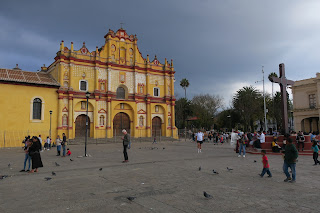San Cristóbal de las Casas, also known by its native Tzotzil name Jovel, is a
town and municipality located in the Central Highlands region of the Mexican
state of Chiapas. It was the capital of the state until 1892, and is still
considered the cultural capital of Chiapas.
The municipality is mostly made up of mountainous terrain, but the city sits
in a small valley surrounded by hills. The city’s center maintains its Spanish
colonial layout and much of its architecture, with red tile roofs, cobblestone
streets and wrought iron balconies often with flowers. Most of the city’s
economy is based on commerce, services and tourism.
|
San Cristóbal City Hall.
The city hall, often called the Palacio de Gobierno, is a Neoclassical
construction which was built in the 19th century by architect Carlos Z.
Flores. It contains a series of arches supported by Tuscan columns.
-
In front of the city hall at night, young men and women promenade past
each other in opposite directions around the gazebo.
-
The city hall is scene to fairly frequent protests, some directly
associated with the Zapatistas and others are held by student
activists from UNAM in Mexico City. These protests are generally
accompanied by lines of riot police.
|
|
Cobblestone street.
The city, especially the historic center, has maintained its Spanish
colonial layout, with narrow cobblestone streets, roofs covered in red
clay tile and wrought iron balconies with flowers. The facades of the
buildings vary from Baroque to Neoclassical and Moorish, painted in
various colors.
|
|
The Cathedral of San Cristóbal Mártir.
The Cathedral is to the north of the main plaza and it is the most
emblematic symbol of the city. However, the main facade does not face
the Zócalo, rather it faces its own atrium which is called the Cathedral
Plaza. The Cathedral began as a modest church dedicated to the Virgin of
the Assumption built in 1528. When Chiapas became a diocese in the 17th
century, with San Cristóbal as its seat, this church was torn down to
build the current structure, dedicated to Saint Christopher, the patron
of the city.
-
The overall structure contains European Baroque, Moorish and
indigenous influences.
|
|
The facade of the cathedral.
The main feature of the church is its main facade, which was finished in
1721. It is Baroque painted yellow with ornamental columns and niches in
which are various saints.
|
|
The facade of the cathedral.
The facade of the cathedral is divided into three horizontal and three
vertical levels marked off by pairs of Solomonic columns and meant to
resemble an altarpiece.
-
It is further decorated with intricate raised stucco work mostly in
white which show Oaxacan and Guatemalan influences.
|
|
Street market at the Cathedral Plaza.
When the sun goes down street vendors set up their sales in the
Cathedral Plaza.
|
See also
Source
Location
San Juan Chamula
San Lorenzo Zinacantán Church
Taller Artesanal Casa de Toña
Sergio Castro Museum
Chiapa de Corzo
Sumidero Canyon






